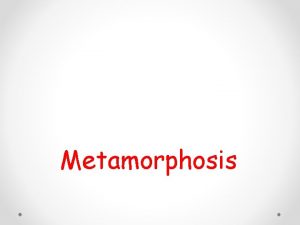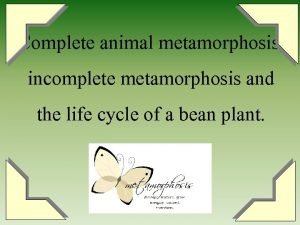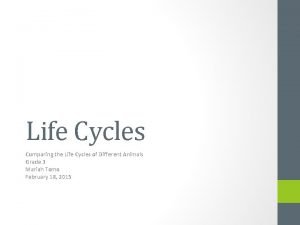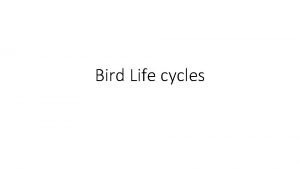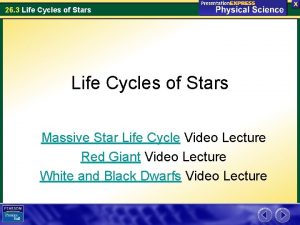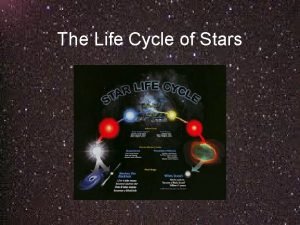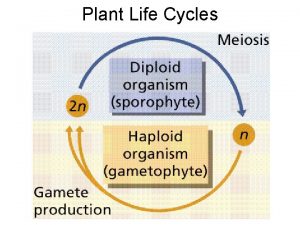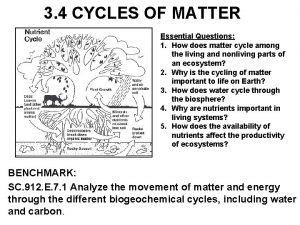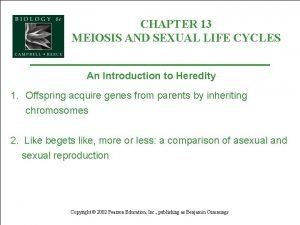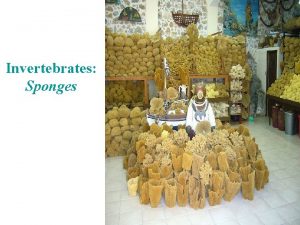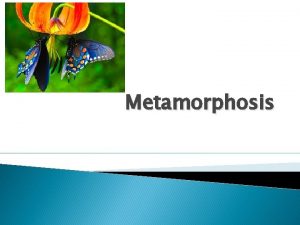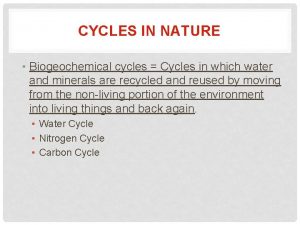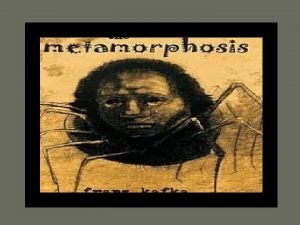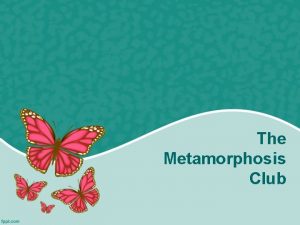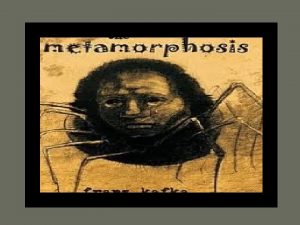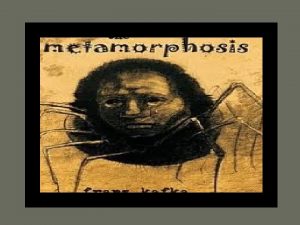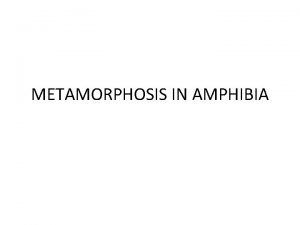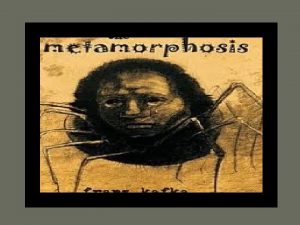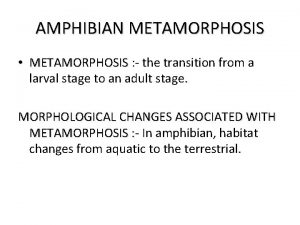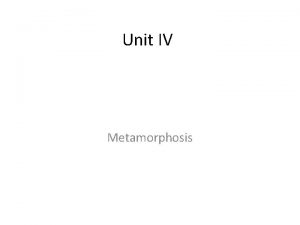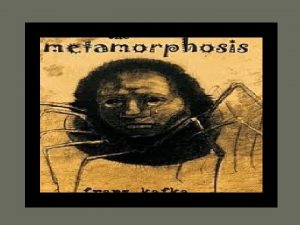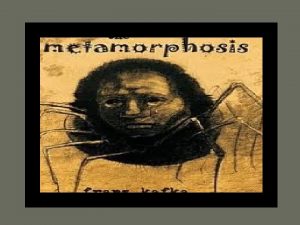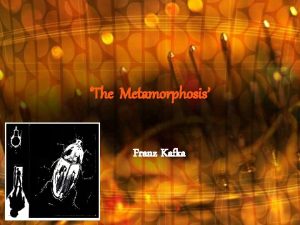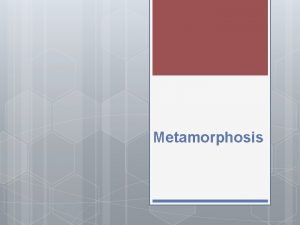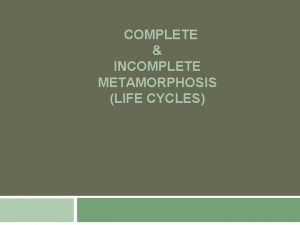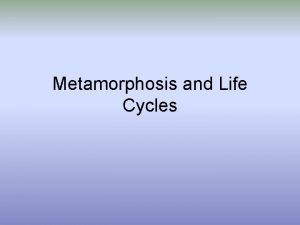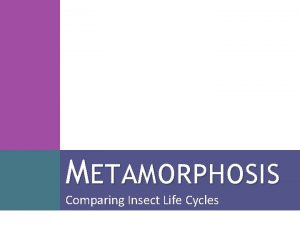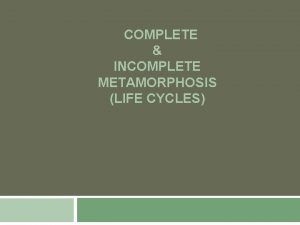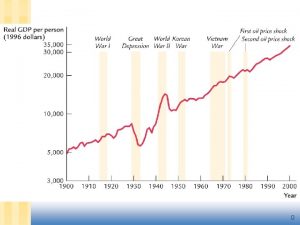Life Cycles Metamorphosis Process in which some animals

























- Slides: 25

Life Cycles

Metamorphosis • Process in which some animals change form at each stage of their life. • Metamorphosis means “change in form”. • There are two types of metamorphosis: Complete Incomplete

Complete Metamorphosis • Complete metamorphosis is the way butterflies, bees, flies, beetles and many other insects develop. • Complete metamorphosis has four stages: egg, larva, pupa and adult.

Egg • Every insect begins life as an egg. The egg is the embryo stage.

Larva • The larva hatches from the egg. The larva is the eating and growing stage. Some insects don’t eat at all after this stage. Larvae don’t look like adults. Caterpillars, grubs and maggots are larvae that grow up to be butterflies, beetles and flies as adults. A larva’s exoskeleton can’t stretch or grow, so the larva sheds its skin, or molts, several times as it grows.

Pupa • When a larva has finished growing, it forms a pupa (plural: pupae). The pupa is the insect’s transforming stage. Outside, the pupa looks as if it’s resting. But inside, the entire body is rearranging. New organs, muscles and body parts develop.

Adult • When it has finished changing, the pupa molts one last time, emerging as an adult. The adult is the reproductive stage. The adult has all the identifiable insect features: three body sections, six legs, two antennae and usually wings.

Complete Metamorphosis

Complete Metamorphosis

Complete Metamorphosis

Incomplete Metamorphosis • Some insects, such as grasshoppers, dragonflies and cockroaches, develop by incomplete metamorphosis. • Incomplete metamorphosis has three stages: egg, nymph and adult.

Egg • Early, basic development happens in the egg.

Nymph • The nymph is the eating and growing stage. Nymphs often look like smaller versions of adults, without wings. The nymph’s exoskeleton can’t grow or stretch, so the nymph needs to shed its skin, or molt, in order to grow.

Adult • The adult is the reproductive stage. The nymph emerges from its final molt as an adult. In species that have wings, the wings don’t fully appear until this stage. Adults mate, females lay eggs, and the cycle begins again.

Incomplete Metamorphosis

Incomplete Metamorphosis

Frog Life Cycle • Frogs and other amphibians live in water when they are young and live on land when they are adults.

Frog Life Cycle

Questions

What is metamorphosis?

The process in which some animals change form at each stage of their life.

Describe the stages in complete metamorphosis.

egg, larva, pupa and adult.

Describe the stages in incomplete metamorphosis.

egg, nymph and adult.
 Complete vs incomplete metamorphosis
Complete vs incomplete metamorphosis Incomplete metamorphosis animals
Incomplete metamorphosis animals Alliteration of cycle
Alliteration of cycle Bill nye life cycles
Bill nye life cycles Kiwi bird life cycle
Kiwi bird life cycle Life cycle of a star assessment
Life cycle of a star assessment Life cycles of stars
Life cycles of stars Style fashion and fad life cycles
Style fashion and fad life cycles Plant life cycles and alternation of generations
Plant life cycles and alternation of generations General fungi life cycle
General fungi life cycle Metaphase ii
Metaphase ii Cycling of matter in an ecosystem
Cycling of matter in an ecosystem Chapter 13 meiosis and sexual life cycles
Chapter 13 meiosis and sexual life cycles Https://a-z-animals.com/
Https://a-z-animals.com/ Animals that eat both plants and animals
Animals that eat both plants and animals G h patel college of engineering and technology
G h patel college of engineering and technology Carnivore
Carnivore The zoo dangerous curves
The zoo dangerous curves Sponges invertebrates
Sponges invertebrates They say it only takes a little faith
They say it only takes a little faith They say sometimes you win some
They say sometimes you win some Cake countable or uncountable noun
Cake countable or uncountable noun Contact vs noncontact forces
Contact vs noncontact forces Fire and ice diamante poem
Fire and ice diamante poem Some say the world will end in fire some say in ice
Some say the world will end in fire some say in ice Some trust in chariots and some in horses song
Some trust in chariots and some in horses song
